 |
|
 |
| |
Ads by Google, based on your browsing history
|
|
2019
December
31
|
When will the Twenties begin?
Everyone is looking back on the decade 2010-2019
(we never came up with a snappy name; the Teens?),
and trying to sum it up and say how the next one will be different.
But I feel that we are not at a natural boundary in our national life.
Whatever the Twenties will be like, either they already started (with a
radical change in politics in 2016) or they won't start until
Trump's present situation is cleared up, perhaps after the election.
I think the defining events for many decades are a few years off from
the nominal boundary. For instance, 1962 was more like the Fifties than the Sixties,
which actually, as a cultural era, spanned about 1964 to 1973.
[Note added later:] In retrospect, it's obvious that the Twenties began with the
coronavirus pandemic that swept through America in March of 2020.
That was the defining event.
I wrote more about this in 2005. Please click here to read it.
Point of pedantry: Yes, I know that the third decade of the 21st Century
doesn't start until 2021. But the Twenties start in 2020. The decade of
years that begin with "201" is ending.
Permanent link to this entry
Looking back on 2019
End of the year already? I'm not ready, or at least I don't feel that
anything is ending or anything new is starting. This was basically a year
of good progress, with much to be thankful for. My consulting practice has
grown to the point that I'm not advertising, and I may soon be announcing
more about what I'm doing. Sharon's medical problems aren't by any means gone,
but now there is nothing unexplained — she's not a medical mystery —
she has a painful shoulder that is responding to investigation and treatment.
We have a new granddaughter, Dorothea, whom we have not yet been able to meet
because minor difficulties have kept us from going to Kentucky.
This is the year we changed churches — am I a Presbyterian now, or a Baptist
in a Presbyterian church? — and we're thriving there.
There has been a general, and welcome, lack of calamities. Deo gratias.
Permanent link to this entry


|
2019
December
28
|
Unfried
I mean that in English, not German, although the German meaning may almost be relevant...
I've just learned that Fry's Electronics, in Duluth, Georgia, closed unexpectedly on December 3.
With the disappearance of Radio Shack and also the industrial suppliers such as RS and Ack,
there is now only one place within an hour's drive of me where electronic parts and tools can be
bought, and it's a small, hobbyist-oriented selection: Micro Center, also in Duluth.
You'll recall that I was happy
when Fry's opened in August 2004,
but less than a year and a half later
I wrote,
"the store is no longer what it initially promised to be. Interesting and useful items are not being restocked (especially electronic components), and the prices on audio equipment were (in our limited experience) not as good as Best Buy and Circuit City. Despite its size, that enormous store is no longer a reliable source of anything hard to find."
But it remained at least somewhat useful until recently, and I'm sad to see it go.
What I'm missing is the experience of getting out of the house, going somewhere, seeing interesting
things, and learning about them. In my younger days I learned a lot about electronics and also
photography in stores — not to mention, of course, the delights of
major bookstores. That doesn't happen any more. We have more information than ever, but
it comes through our computers, and we don't get to even get out of the chair.
Permanent link to this entry
The great e-mail roundup
Yesterday, my ISP reconfigured its server, and for a while I thought my IMAP folders had disappeared.
I realized I had an inordinate amount of personal and business records stored in my e-mail folders,
some messages going back more than 20 years.
I exported and saved the existing accumulation as MBOX files, the most standard format for e-mail,
importable into almost any mail reader. Thunderbird can only export from local folders, not IMAP folders,
so I spent hours getting everything copied into local folders. But now it's on my server, and if
anything happens to my ISP's server, I have backup copies.
Of course I'll need to do this periodically, perhaps yearly. I won't wait 22 years next time.
And this is why I don't do 3 hours of billable consulting work every day.
Some work days are consumed entirely by overhead.
Permanent link to this entry


|
2019
December
26
|
Christmas 2019

Melody, Sharon, and I had a low-key, low-energy, but happy Christmas.
A highlight was that Sharon was able to go to church with us at Alps Road.
Due to a couple of people's minor medical problems, we didn't go to Kentucky
to see the grandchildren, nor have a large gathering of Melody's family here.
In fact, I had a busy mid-December and still have plenty of work to do.
(Today's topic: Regular expression optimization and backtracking. It's a lot
like Prolog, but illegible.)
We didn't exchange many presents, but, as usual, Sharon gave me the funniest,
a pair of computer-security-themed socks:

Yes, a product of Sophos. And note the mention of unicorn hair.
This was rivaled by a
Strange Planet cartoon book
from Cathy, Nathaniel, and the grandchildren.
The cartoons show people saying commonplace things with unusual choice of words,
such as "I have ingested the sweet discs" for "I ate the cookies."
Probably three quarters of humanity would just find this frustrating.
We find it funny, but, as a linguist trained extensively in semantics,
I almost think that way already.
Permanent link to this entry
Latest round in Nikon vs. Canon DSLR war
More information has come out about why Nikon DSLRs perform so differently from Canons
in astrophotography — and the question which is better is a more interesting dilemma
than it used to be. I'm thinking about low-cost DSLRs such as the Nikon D5500 and Canon EOS SL3/250D.
For particulars click here and follow the links.
Basically:
- Nikon postprocesses the raw images to eliminate hot pixels, and you can't turn this off.
Fortunately, it does not harm astrophotos — in fact it improves them — but it does
give the photographer less control than one might expect.
- Canon's sensor genuinely has more read noise than Nikon's, and this isn't attributable to
differences in postprocessing, as far as we can tell. But the difference is small, at most 1 stop
and probably half that.
- Canon has other selling points such as vibrationless Live View shooting (EFCS), ability to take
clip-in filters, and ability to take Nikon, Olympus, and Pentax lenses with adapters.
More to come as I find out more.
Permanent link to this entry


|
2019
December
25
|

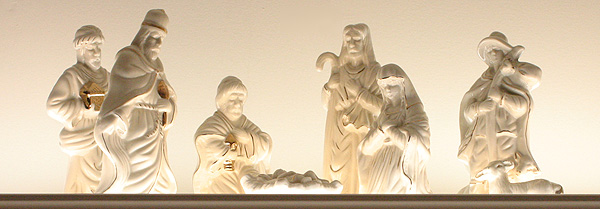



|
2019
December
21
|
No more two-headed Pythons?
With a great sigh of relief I greet the news that
Python 2 is being discontinued imminently and Python 3 will be
the only supported version.
For far too long, we have had two programming languages called Python,
and an undue amount of cleverness was expended on making them coexist.
There are ways to mark programs so they will run in the Python you want,
and ways to import Python 3 features into Python 2 programs, and so forth.
Now make sure you use the online Python 3 edition of the NLTK book...
Permanent link to this entry
Nebulae in hydrogen-alpha
On the evening of the 19th, we had clear weather, and I attempted to cut through the
city glow of Athens by narrowband imaging.
That is, I used a Lumicon H-alpha filter (a dye filter, not an interference filter)
in front of my Sigma 105-mm f/2.8 lens (at f/4) and H-alpha-modified Nikon D5500.
The result was a set of black-and-white pictures formed only by light with a wavelength
near 656 nm. The pictures come out somewhat grainy because I'm using only 1/4 of the pixels
on the sensor.
To start, here's a test shot of a familiar region in Orion, just to show how the technique works.
This is a stack of one 4-minute and two 3-minute exposures.

Permanent link to this entry
The Spaghetti Nebula (Simeis 147) and LBN 826
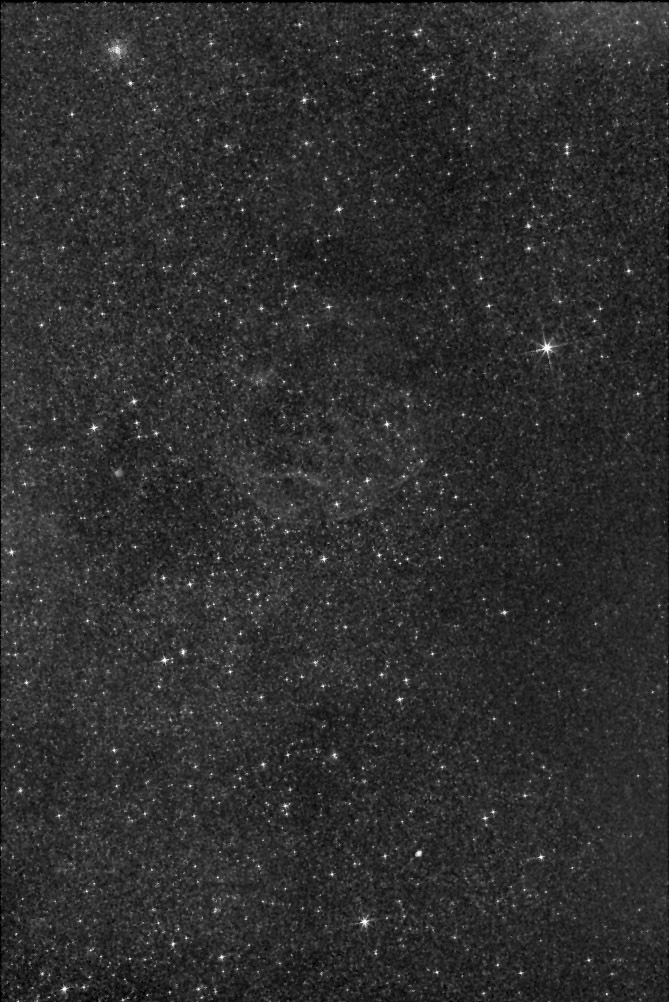
My real target for the night was the round wispy thing barely visible in the middle
of this picture. I can't say this is a good image of it, but you can at least detect
the Spaghetti Nebula, as some call it.
What you can see, very clearly, is a little-known nebula known as LBN 826,
a compact bright cloud around a star to the left of center. LBN 826 wasn't plotted
on the star maps I looked at, and at first I wondered if I'd discovered something.
Stack of 15 3-minute exposures, same equipment as above.
Permanent link to this entry
Flaming Star Nebula (IC 405)
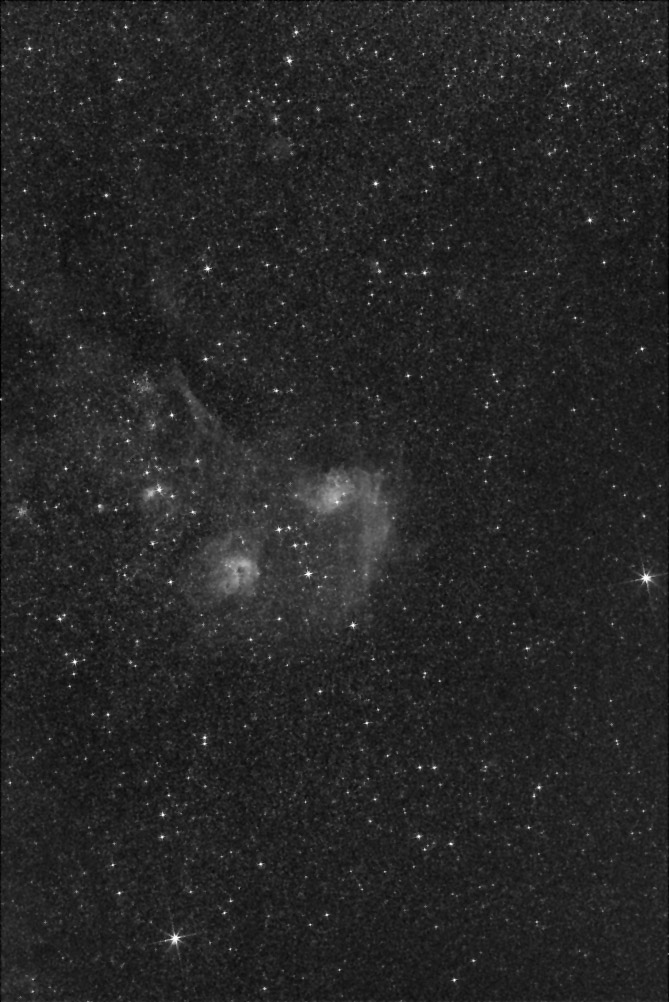
Here's a much easier-to-photograph nebula in Auriga
which I've photographed before.
Again, stack of 15 3-minute exposures.
Permanent link to this entry


|
2019
December
15
|
Did I photograph Mare Orientale?
The most spectacular feature on the moon is Mare Orientale, but most of it is not visible
from earth; it is right at the edge of the side of the moon that is turned toward us.
Fortunately, we don't view the moon exactly face-on all the time. Because the moon's orbit
is not a perfect circle, and because we are not viewing from the center of the earth,
we can sometimes peek around the edges a little. On the evening of the 11th, I realized that
the angle from which we were viewing the moon was advantageous, and I got out my 5-inch
telescope and tried to photograph what little of Mare Orientale I could.
First let me show you a Lunar Orbiter image (from
Virtual Moon Atlas) to show you what you're missing.
If you could view Mare Orientale straight on, it would look like this:
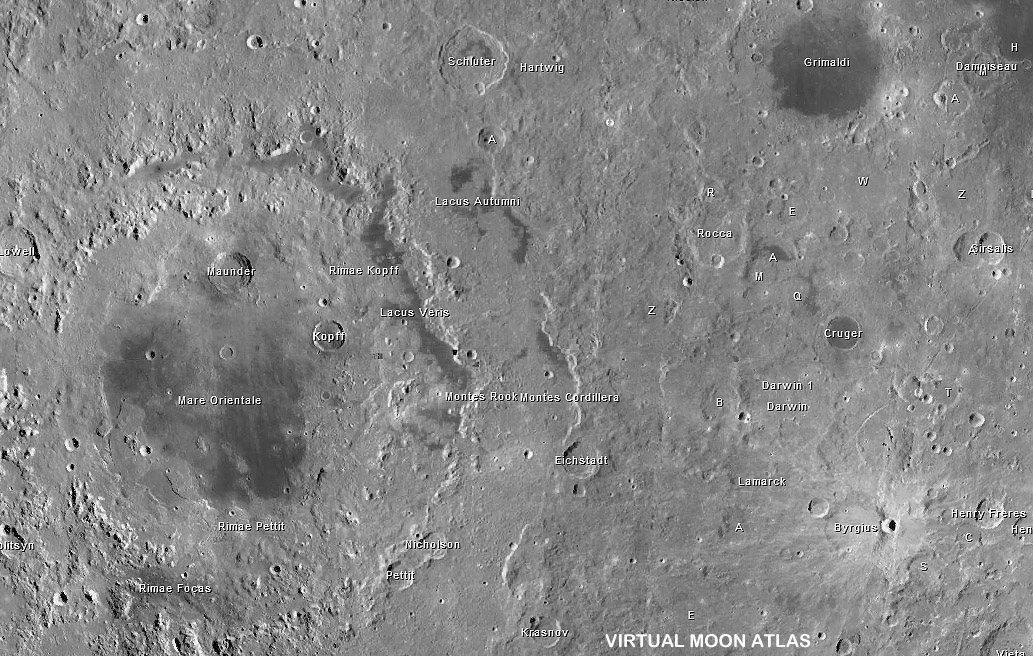
But that's not what it looks like from here. The best view I've had so far still didn't
show me the dark central floor of Mare Orientale, which is sometimes just visible from earth.
But it did show me the two concentric mountain ranges (Montes Cordillera and Montes Rook)
and some territory that is definitely beyond them:
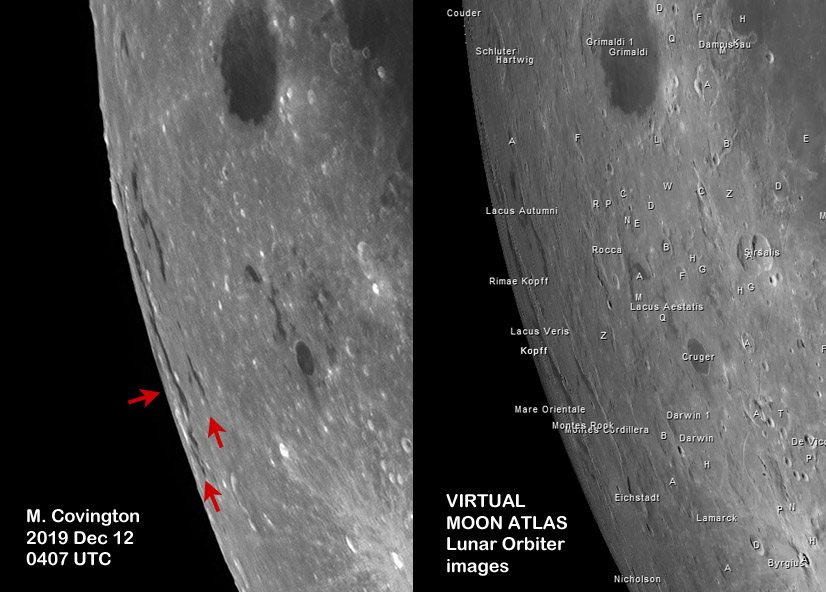
My picture is very flatly illuminated because it was taken at full moon, with the sunlight
shining onto the moon from the exact direction from which I'm viewing it.
So you can't see the shapes of craters; they are too flatly lit.
But the infrared images make the darker parts of the moon's surface stand out;
that's how you can recognize the two mountain ranges, and Lacus Autumni is quite
striking.
Stack of the best 75% of about 1900 video images, ASI120MM-S camera, infrared-pass filter,
Celestron 5 telescope, processed with AutoStakkert and RegiStax.
Permanent link to this entry
How to record your computer's audio output
Handy tip: To make a digital recording of the audio coming out of your computer's speakers,
use Audacity software (free)
and set your audio interface to "Windows WASAPI."
You can then select your speakers as an input device (marked as "loopback").
You can't set input levels; Audacity gets whatever is being sent to the speakers.
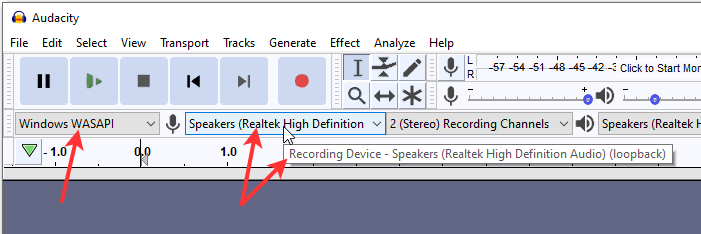
Permanent link to this entry


|
2019
December
14
|
A despicable episode in Valdosta history
The lynching of Mary Turner and others in May, 1918
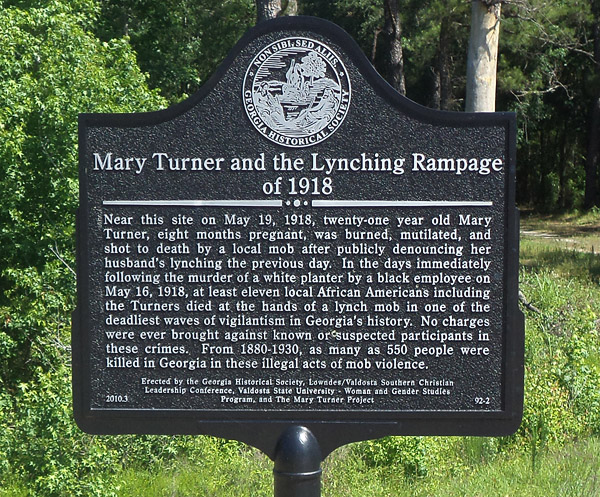
I have just been aghast to learn of a shameful episode in the history of my
home town, Valdosta, Georgia. If I had been paying attention, I would probably have heard
of this 1918 atrocity in 2010, when a historical marker was erected
and the newspaper covered it.
But I didn't hear of it growing up, nor later, even though I've kept up
some interest in Valdosta history.
In fact, a historian mentioned in Wikipedia
found the county historical society unaware of it in the 1990s,
even though it had been well publicized back in 1918.
I refer you to Wikipedia for the gruesome
story, which is too nauseating to retell. Suffice it to say that Mary Turner was not just killed;
it was much worse than that. And although there had been, and continued to be, other lynchings in the area,
what made this one particularly diabolical is that Ms. Turner was not even accused of a crime.
It is disconcerting to realize that when I was a boy in Valdosta, about 40 to 50 years later, there
must have been many people alive who remembered the incident, and some who had participated in it.
But it was never mentioned and is not in the two books about Valdosta history that I know of.
Only once during my adolescence do I remember an adult mentioning that there had been lynchings
in the area, and that was completely without details.
But this may explain why there was fear of "race riots" in the late 1960s. People alive at the time
knew full well that their predecessors had done things that might provoke violent retribution.
In particular, I remember a weekend
in 1968 or 1969 when rumors were flying, but there was no sign of an actual riot. It occurs to me now that
it might have been the 50th anniversary of the lynching rampage.
It also makes the town's fixation on high-school football more excusable. Football was the only
local institution that undeniably and obviously benefited from racial integration. It may have been
the thing that kept a racial powder keg from exploding.
By the way, I can take some solace that none of my ancestors were in Lowndes or Brooks County in 1918
(my father was from farther north, and my mother, from farther west), so they, at least, were
not involved.
Permanent link to this entry


|
2019
December
10
|
Short notes
I wrote about a short skirmish with the flu on December 2 and then didn't write anything else
for eight days — you're probably imagining I've been down with the flu.
Not so. I'm fine, but Melody is having some back trouble and I am again the family's driver
and errand-runner. That, on top of a thriving software business, keeps me busy.
I've posted nothing about societal or political matters for a while, since the situation is too
volatile, but I do have one exhortation for anyone following the impeachment:
Follow the facts. Everything depends on what people actually did, in fact about rather
fine details of what they did, and also on facts about the laws. And I would add that
a fair trial is one that is decided on the facts, not political pledges made years earlier.
What would we think about any other kind of trial in which the jury had taken sides long in
advance?
In other news, I shifted my attention from electronics projects to some infrastructure
modernization. I found a place in my workshop where a 20-amp circuit had been extended
with #14 (15-amp) wire, and I need an outlet added, and elsewhere there were extension cords that
need to be replaced by permanent wiring. We're going to have an electrician in, but first
I need to scout everything out. And there is also a possibility that my darkroom will be
operational in a few weeks, for the first time since four years ago. Or not, depending on how
busy I am with other things!
Permanent link to this entry


|
2019
December
2
|
Two-transistor overvoltage protection for shortwave radio antenna input
A two-transistor
bidirectional Zener clamp
makes a very good "static protector" for the input of a shortwave radio.
It protects against static electricity and also voltages induced by thunderstorms in the area
(which can be hundreds of volts even if not very close to a lightning strike).
I added one to my antenna tuner, so its complete circuit is now what is shown below.
The red components are added to the classic antenna tuner circuit.
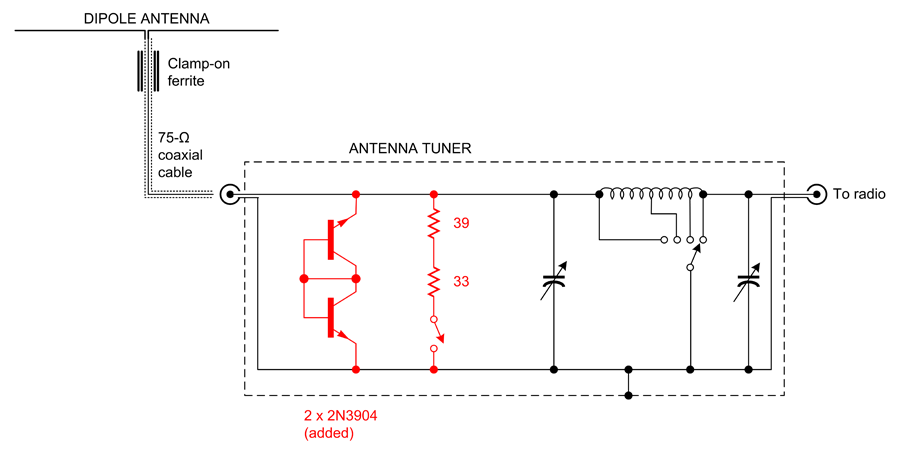
Unlike the traditional pair of diodes, the bidirectional clamp doesn't turn on until
it reaches about 8 volts; that means it won't be affected by strong signals from nearby
AM stations or power lines. But, unlike a Zener diode, it has very little leakage and little
capacitance. The MPF102 input transistor in my radio can tolerate 25 volts, so an 8-volt
clamp is sufficient, I think.
You can see that I also made the resistor termination switchable. The reason? With the resistors
in place (switch closed), the antenna picks up less noise but is also less tunable; it loses a lot
of sensitivity at frequencies other than the one it is cut for. With the resistors removed (switch
open), it is much more tunable. For more about this,
click here.
Here's what the two-transistor clamp looks like, assembled:
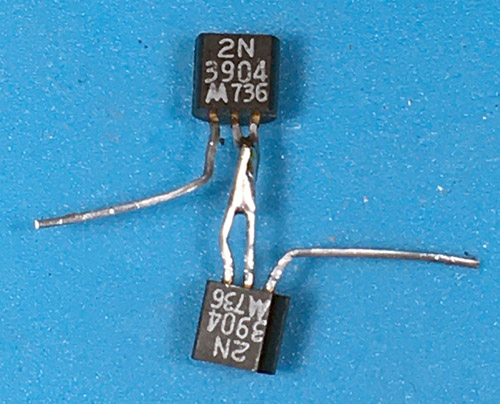
And here's what my ancient Tektronix transistor curve tracer tells me about the threshold voltages
(2 volts per division):
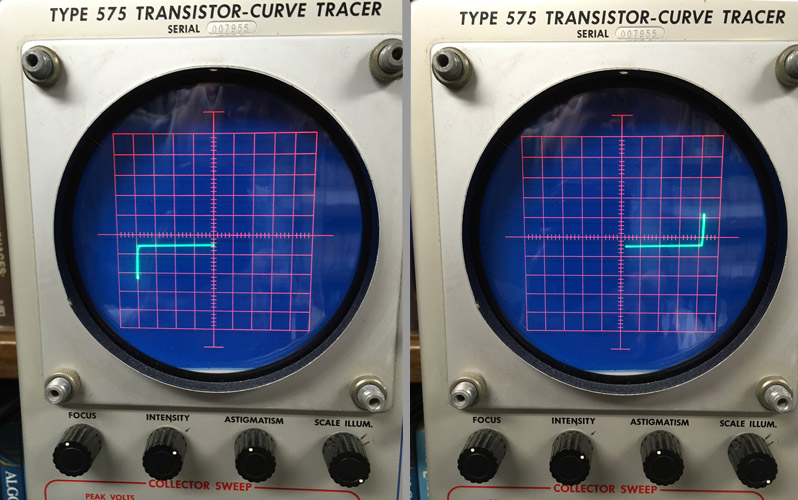
Note: I would consider selling this instrument (local pickup in Athens, Georgia, only; it weighs
75 pounds). It is fully functional but hasn't had any substantial maintenance in several years.
Contact me if you want to make an offer.
Permanent link to this entry
Flu express
This notebook entry is the only thing I've produced today (for anyone) because I'm taking a sick day.
Last night I appeared to have the flu, but only for eight hours or so, though there is a lingering
slight fever. I've had this experience in several recent years; maybe the vaccine enables me to fight off the
viruses with only a short battle. Or maybe it's something else.
Permanent link to this entry


|
2019
December
1
|
Replacing a tuning-eye tube
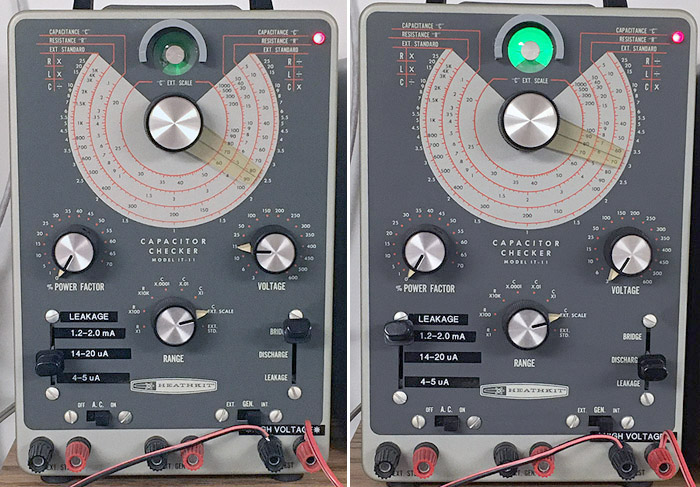
Happy new month! And a blessed First Sunday in Advent to all.
If you didn't see yesterday's entry about the noble art
of electronic repair, and why the repair business is a lot like the insurance business,
click here
and read it. Then proceed...
On Saturday I did something in my workshop that is rarely done in this century.
I replaced a tuning-eye tube.
As you can see, it made a dramatic difference. But what is this contraption?
It's a vacuum tube that glows green on one end, and part of the green glow is blocked off,
depending on a signal voltage applied to it. Above, you see it as the display device on my
somewhat souped-up Heathkit capacitor tester.
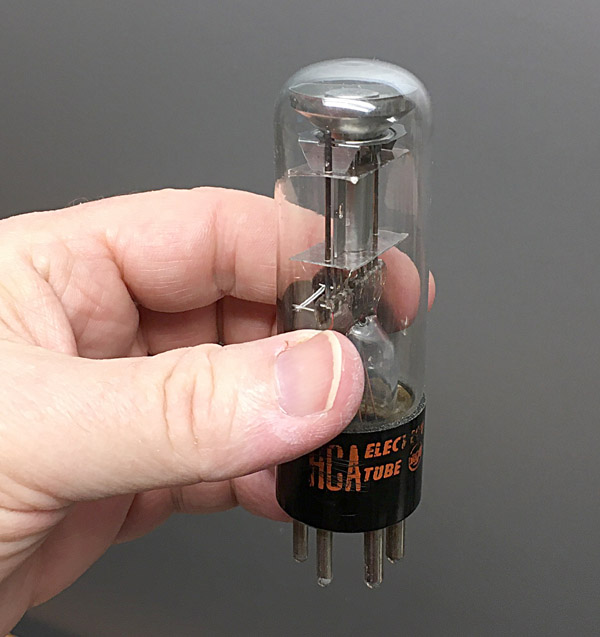
Back in the 1930s, radio manufacturers wanted to include a meter in the radio, to help
people tune each station exactly. (Tune for the highest meter reading.) But meters are
expensive, and there would also need to be a tube to amplify the signal for the meter.
Further, the purpose of such a meter is just to find the maximum — it doesn't have to
have a calibrated scale.
So someone had the idea of building an indicator device into the amplifying tube itself.
The "tuning eye" is what resulted.
It looks rather like an eye, hence the name.
By the 1960s, tuning eyes were rare; everybody got good local radio reception and didn't
feel the need for a tuning aid. Shortwave radios for serious listeners had meters, not
tuning eyes. So the technology was almost obsolete...
But tuning eyes hung on in a few kinds of test equipment, notably capacitor testers.
My Heathkit IT-11 has one. And what I didn't know, when I bought that instrument about
a quarter century ago, was that its tuning eye was on its last legs. It was hard to see.
I can put up with a dim display for 25 years, but not forever.
So I replaced the tube.
Here are the old and new ones, for comparison. The phosphor in the old one
has deteriorated and turned brown. The new one (about 60 years old, but never used, and
fresh in its RCA box from an eBay vendor) is tremendously brighter.

There is an excellent video about eye tubes at this
link, for Patreon subscribers to "Mr. Carlson's Lab." My recollection is that you can subscribe
for one month for $2, well worth it.
Permanent link to this entry


|
|
|
This is a private web page,
not hosted or sponsored by the University of Georgia.
Copyright 2019 Michael A. Covington.
Caching by search engines is permitted.
To go to the latest entry every day, bookmark
http://www.covingtoninnovations.com/michael/blog/Default.asp
and if you get the previous month, tell your browser to refresh.
Portrait at top of page by Sharon Covington.
This web site has never collected personal information
and is not affected by GDPR.
Google Ads may use cookies to manage the rotation of ads,
but those cookies are not made available to Covington Innovations.
No personal information is collected or stored by Covington Innovations, and never has been.
This web site is based and served entirely in the United States.
In compliance with U.S. FTC guidelines,
I am glad to point out that unless explicitly
indicated, I do not receive substantial payments, free merchandise, or other remuneration
for reviewing or mentioning products on this web site.
Any remuneration valued at more than about $10 will always be mentioned here,
and in any case my writing about products and dealers is always truthful.
Reviewed
products are usually things I purchased for my own use, or occasionally items
lent to me briefly by manufacturers and described as such.
I am no longer an Amazon Associate, and links to Amazon
no longer pay me a commission for purchases,
even if they still have my code in them.
|
|




















